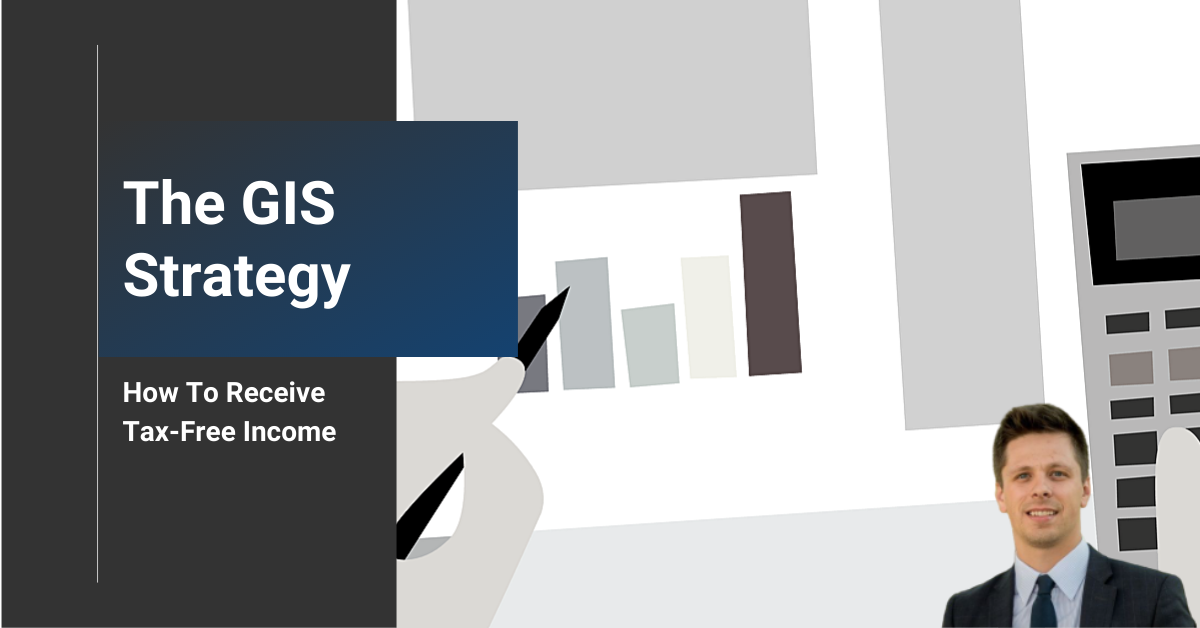[vc_row][vc_column][vc_video link=”https://youtu.be/4RmIFXCjoaM” css=”.vc_custom_1615868841483{padding-top: 20px !important;padding-bottom: 20px !important;}”][vc_column_text]As an Investment Advisor and Certified Financial Planner, I’m relied upon to reduce my client’s tax bill as much as possible. Today, I wanted to share with you a strategy that, if implemented correctly, can see your family receive nearly $140,000 tax-free from the government. That’s a lot of money in your pocket for merely doing some wise tax planning.
For this strategy to be effective, you need to:
- Be comfortable with deferring your CPP to age 70 (it still works if you are receiving CPP, but it won’t be as effective)
- Have access to tax-free income such as a TFSA, non-registered account, home equity.
The GIS Strategy
Where to begin
The goal of this strategy is to have $0 of income on your tax return in the year you turn 64. You may be wondering why that’s important?
At age 65, you are eligible to begin receiving your OAS (Old Age Security) pension. If you’ve lived in Canada for 40 years, you will qualify for the maximum OAS payout, which is currently $613.53/m.
Additionally, you can be eligible for GIS (Guaranteed Income Supplement) if you and your spouse have a low income. This is an additional tax-free payout on top of OAS for “low income” seniors. The amount you receive from GIS will depend on the income that you and your spouse show in the tax year that you turn 64. If you’re able to show an income of $0, you will each (assuming you are both 65) receive the maximum GIS payout, which is currently $551.63/m for a family total of $1,103.26/m.
GIS payments are reduced as your family income increases and will eventually be nullified if your combined income is above $34,416 (excluding OAS, GIS payments). That’s why it’s essential to have as low of an income as possible. See the links below to see how much you could receive based on your income.
If you are married or common-law partners, both receiving a full Old Age Security pension https://www.canada.ca/en/services/benefits/publicpensions/cpp/old-age-security/payments/tab2-1.html
If you are receiving a full Old Age Security pension whose spouse or common-law partner does not receive an OAS pension https://www.canada.ca/en/services/benefits/publicpensions/cpp/old-age-security/payments/tab3-1.html
For individuals: https://www.canada.ca/en/services/benefits/publicpensions/cpp/old-age-security/payments/tab1-1.html
If done correctly, both you and your spouse will receive $1,165.16/m between OAS and GIS. That’s a family income of $28,000, and it would all be tax-free. If you can keep repeating this strategy to age 70, that will be $140,000 in tax-free income.
How do I keep my income low for so many years?
- Defer your CPP to age 70
Rather than taking your CPP at 60 or 65, deferring it until age 70 will keep your income as low as possible. As previously mentioned, this strategy will still work if you have CPP income, but you will receive less GIS.
An additional benefit to deferring your CPP to 70 is a payout increase of 42% once you begin payments.
- Make sure you have additional sources of tax-free income.
“I’m glad to be receiving $28,000 per year tax-free, but that won’t be enough to sustain the lifestyle we want.”
Withdrawals from your non-registered accounts, TFSA, and home equity can potentially all be considered tax-free. If you’ve built these up, you’ll be able to supplement your income without it affecting your GIS.
I.E., John and his wife withdraw $32,000 per year from their TFSA’s. This brings their tax-free income up to $60,000, which pays them $5,000 per month.
- Don’t make any withdrawals from taxable registered accounts between age 64-71
Any withdrawal made from an RRSP, RRIF, LIRA, or LIF… would be considered taxable income. This income would, in turn, reduce your GIS. In this case, it would be better to wait until age 71 to convert your RRSP into an RRIF or LIRA into a LIF. Once funds are in an RRIF or LIF, you are required to make yearly withdrawals from those accounts. By deferring this conversion to 71, you have more years available to keep your income as low as possible.
You could also make RRSP withdrawals before you turn 64 to build up your TFSA and non-registered account to have access to tax-free money.
What else should I know?
- Be wary of hidden sources of income
As mentioned, any income you receive that is taxable will reduce what you receive in GIS. Including:
- Income from a part-time job
- Business income paid to you
- Interest in your savings account
- Reducing your income with an RRSP contribution
If you have RRSP contribution room remaining, it may make sense to use it to reduce your income to $0.
I.E., Janet started her CPP at 60 before hearing about this strategy. She’s currently 65 and makes $5,000 per year from her CPP. Janet has an RRSP contribution room available, and by transferring $5,000 from her TFSA to her RRSP, she’s able to reduce her taxable income to $0. This will allow her to get the maximum amount of GIS.
- If you have a non-registered account, be careful of how it’s invested.
If your investments produce dividends or interest, you will need to add this to your taxable income. Try to focus on investments that produce capital gains instead. You only have to add the gain to your taxable income in the year that you dispose of the investment.
- Make sure the benefits outweigh the negatives of using your home equity.
With interest rates so low, accessing the equity in your home has never been cheaper. The most effective way to do so is through a Home Equity Line of Credit, as you will get a very low-interest rate.
Don’t forget that you will need to pay the interest at a minimum on any equity withdrawn. There is also a cost to set these up on your home, which may make this strategy inefficient. Some home insurance companies will also charge a higher premium if there is a lean from a lender against the property. This is an additional factor to consider if you are currently mortgage-free.
Does this strategy make sense for you?
A lot of planning is required to make this strategy as effective as possible. If you’d like to explore if this makes sense for you, don’t hesitate to reach out.[/vc_column_text][/vc_column][/vc_row]





